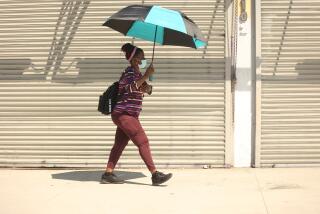They can take the heat
- Share via
I have lived almost all my life in Riverside, so I know true heat. August is when my three daughters used to lie on the wood floor, sucking on peppermints while a fan blew over them. I’d told them that was how I cooled off when I was a child and the summer pressed down outside like a golden electric blanket turned far too high by agiant who coughed up some smog for good measure.
True heat is 105, 107, 109. I’ve felt it every summer of my four decades, the blast furnace of asphalt parking lots, the hills covered with grass brittle and brown. Actually, there is some green in summer -- the tumbleweeds growing fat and complacent in their fields of burnt wild oats, the tumbleweeds blue-green as mirage-like ponds.
When I was a child, sometimes my mother took me and my brothers to Blythe or Indio, and if it was 105 in Riverside, it was 112 there. I remember standing in the heat of a date grove, the air so hot and dry it was painful to open my eyes and see the paper bags covering the tender dates. In Indio and Blythe, we learned to come out at night, when the cicadas seemed to pull the heat into their bodies and the day actually began in the desert.
We were proud of our resilience and toughness in the heat. My brothers and I climbed Sugarloaf Mountain at midday, our faces red with sunburn that peeled off our nose skin, looking for the blue-throated lizards that didn’t mind the blazing granite. In the afternoons, we walked along railroad tracks, the rails shimmering so hot they could sear your fingers, to the city pool, where our blond hair turned green as lime Kool-Aid. And at night, when my mother wouldn’t turn on the ancient, inefficient air conditioner, I slept at my windowsill, breathing in the rust smell of the screen.
When I was 37 and my daughters were much younger, I was a single mother in an old bungalow with no air conditioning, and I didn’t want my girls quite that tough. I felt the heat more, tired from working and cooking and trying to keep everyone alive. I was broke and desperate and, for the first time, I didn’t think I’d survive summer.
We had ceiling fans and large windows we left open. And all afternoon, we splashed water on ourselves, ate the mints, lay flat on the floor. For dinner, we lived on nectarines from the backyard, boiled eggs, sweet corn and ice cream. Popsicles four, five times a day. Me too.
When the 100-degree days stretched to weeks, I got up at dawn to pick the fruit. I was already sweating, and the air was syrupy gold. I washed clothes and hung out laundry that dried stiff, like flat people, in half an hour. We got through the days by walking in a mall and walking through sprinklers.
No one could sleep at night. Finally, at around 10, I’d spread sheets on the front lawn, and we all dampened our T-shirts and lay like silverware, separate on the grass. It was magical. The mulberry tree’s leaves shifted when the breeze finally came, and when the smog blew to the west, we could see the stars. I touched the baby’s forehead back then -- she was 2 -- and her hair was always beaded with sweat, like a crown of diamonds.
She had been born Aug. 30, on a day that reached 109 in Riverside, a day after a long night when I knew I was in labor and sat on the porch until 3 a.m. I rocked in an old glider, and after midnight, a coyote loped down the center of my street, straight and true as if he loved the painted dashes under his paws.
Now my baby girl is 10; the other two are teenagers, and the house has air conditioning. My neighbor installed it; said he’d felt sorry for us when we slept out on the grass. He’d seen me pick up my daughters one by one, around 2 in the morning, after I’d been awakened by passing footsteps on the sidewalk. I’d take the girls inside, their legs dangling, and lay them under the fans.But I still stay out on the porch after midnight. That late and many lights are on down my street. Fruit falls from trees, thudding to the ground, and I see the police helicopter knifing a silver beam like a thin blade, surgically excising someone from a parking lot or sidewalk.
Another glass of iced tea, and I can watch the yellow summer moon rise between two Washington palms across the street, then dangle for a long minute from the telephone wire like a bone pendant. Coyotes converse in their surreal chatter, gathering in the arroyo that marks the end of my street, and a family of raccoons comes up from the storm drain. We are all thirsty.
I hear the drip of all the swamp coolers hanging in all the windows. Tiny, hesitant waterfalls everywhere. Springs, maybe, to the animals at night. And in the morning, when I’ve slept only a few hours, in the aching heat a swallowtail butterfly drinking from the damp gravel there, not caring that I am close, moving its wings like an intricate fan.
Out here, we all know how to live in the inland kiln of summer. It makes us both tough and companionable.







